The Influence of Surfactants on the Deposition and Performance of Single-Walled Carbon Nanotube-Based Gas Sensors for NO2 and NH3 Detection
Abstract
1. Introduction
2. Materials and Methods
2.1. Fabrication of Microheater Chemiresistive Gas Sensing Platform
2.2. Preparation of SWCNT Dispersions
2.3. SWCNT Spray Deposition on Chemiresistive Gas Sensing Platform
2.4. SWCNT Material Characterization
2.5. Gas Measurement Setup
3. Results and Discussion
3.1. SWCNT Film Characterization
3.2. Gas Sensing Performance
3.2.1. CMC-SWCNT and SDS-SWCNT Responses to NO2 and NH3 in Dry Conditions
3.2.2. Effect of the Relative Humidity (RH%) on the Sensor Response
3.2.3. Effect of the Temperature on the Sensor Response
3.2.4. Cross-Sensitivity Characterization
3.3. Sensing Mechanism
4. Conclusions
Author Contributions
Funding
Institutional Review Board Statement
Informed Consent Statement
Data Availability Statement
Acknowledgments
Conflicts of Interest
References
- Santos, F.J.; Galceran, M.T. The Application of Gas Chromatography to Environmental Analysis. Trends Anal. Chem. 2002, 21, 672–685. [Google Scholar] [CrossRef]
- Rajawat, J.; Jhingan, G. Mass Spectroscopy. In Data Processing Handbook for Complex Biological Data Sources; Elsevier: Amsterdam, The Netherlands, 2019; pp. 1–20. ISBN 978-0-12-816548-5. [Google Scholar]
- van Stee, L.L.P.; Brinkman, U.A.T.; Bagheri, H. Gas Chromatography with Atomic Emission Detection: A Powerful Technique. Trends Anal. Chem. 2002, 21, 618–626. [Google Scholar] [CrossRef]
- Ng, L.M.; Simmons, R. Infrared Spectroscopy. Anal. Chem. 1999, 71, 343–350. [Google Scholar] [CrossRef] [PubMed]
- Zhou, T.; Zhang, T. Recent Progress of Nanostructured Sensing Materials from 0D to 3D: Overview of Structure–Property-Application Relationship for Gas Sensors. Small Methods 2021, 5, 2100515. [Google Scholar] [CrossRef]
- Jakubik, W.P. Surface Acoustic Wave-Based Gas Sensors. Thin Solid Film. 2011, 520, 986–993. [Google Scholar] [CrossRef]
- Tierney, M.J.; Kim, H.O.L. Electrochemical Gas Sensor with Extremely Fast Response Times. Anal. Chem. 1993, 65, 3435–3440. [Google Scholar] [CrossRef]
- Brauns, E.; Morsbach, E.; Kunz, S.; Bäumer, M.; Lang, W. A Fast and Sensitive Catalytic Gas Sensors for Hydrogen Detection Based on Stabilized Nanoparticles as Catalytic Layer. Sens. Actuators B Chem. 2014, 193, 895–903. [Google Scholar] [CrossRef]
- Bogue, R. Detecting Gases with Light: A Review of Optical Gas Sensor Technologies. Sens. Rev. 2015, 35, 133–140. [Google Scholar] [CrossRef]
- Vashist, S.K.; Vashist, P. Recent Advances in Quartz Crystal Microbalance-Based Sensors. J. Sens. 2011, 2011, 1–13. [Google Scholar] [CrossRef]
- Gaiardo, A.; Novel, D.; Scattolo, E.; Crivellari, M.; Picciotto, A.; Ficorella, F.; Iacob, E.; Bucciarelli, A.; Petti, L.; Lugli, P.; et al. Optimization of a Low-Power Chemoresistive Gas Sensor: Predictive Thermal Modelling and Mechanical Failure Analysis. Sensors 2021, 21, 783. [Google Scholar] [CrossRef]
- Valt, M.; Caporali, M.; Fabbri, B.; Gaiardo, A.; Krik, S.; Iacob, E.; Vanzetti, L.; Malagù, C.; Banchelli, M.; D’Andrea, C.; et al. Air Stable Nickel-Decorated Black Phosphorus and Its Room-Temperature Chemiresistive Gas Sensor Capabilities. ACS Appl. Mater. Interfaces 2021, 13, 44711–44722. [Google Scholar] [CrossRef]
- Gregis, G.; Sanchez, J.-B.; Bezverkhyy, I.; Guy, W.; Berger, F.; Fierro, V.; Bellat, J.-P.; Celzard, A. Detection and Quantification of Lung Cancer Biomarkers by a Micro-Analytical Device Using a Single Metal Oxide-Based Gas Sensor. Sens. Actuators B Chem. 2018, 255, 391–400. [Google Scholar] [CrossRef]
- Fabbri, B.; Valt, M.; Parretta, C.; Gherardi, S.; Gaiardo, A.; Malagù, C.; Mantovani, F.; Strati, V.; Guidi, V. Correlation of Gaseous Emissions to Water Stress in Tomato and Maize Crops: From Field to Laboratory and Back. Sens. Actuators B Chem. 2020, 303, 127227. [Google Scholar] [CrossRef]
- Gaiardo, A.; Bellutti, P.; Fabbri, B.; Gherardi, S.; Giberti, A.; Guidi, V.; Landini, N.; Malagù, C.; Pepponi, G.; Valt, M.; et al. Chemoresistive Gas Sensor Based on SiC Thick Film: Possible Distinctive Sensing Properties Between H2S and SO2. Procedia Eng. 2016, 168, 276–279. [Google Scholar] [CrossRef]
- Gomri, S.; Seguin, J.-L.; Guerin, J.; Aguir, K. Adsorption–Desorption Noise in Gas Sensors: Modelling Using Langmuir and Wolkenstein Models for Adsorption. Sens. Actuators B Chem. 2006, 114, 451–459. [Google Scholar] [CrossRef]
- Jian, Y.; Hu, W.; Zhao, Z.; Cheng, P.; Haick, H.; Yao, M.; Wu, W. Gas Sensors Based on Chemi-Resistive Hybrid Functional Nanomaterials. Nano-Micro Lett. 2020, 12, 71. [Google Scholar] [CrossRef]
- Chen, M.; Wang, Z.; Han, D.; Gu, F.; Guo, G. Porous ZnO Polygonal Nanoflakes: Synthesis, Use in High-Sensitivity NO2 Gas Sensor, and Proposed Mechanism of Gas Sensing. J. Phys. Chem. C 2011, 115, 12763–12773. [Google Scholar] [CrossRef]
- Chowdhury, N.K.; Bhowmik, B. Micro/Nanostructured Gas Sensors: The Physics behind the Nanostructure Growth, Sensing and Selectivity Mechanisms. Nanoscale Adv. 2021, 3, 73–93. [Google Scholar] [CrossRef]
- Gaiardo, A.; Zonta, G.; Gherardi, S.; Malagù, C.; Fabbri, B.; Valt, M.; Vanzetti, L.; Landini, N.; Casotti, D.; Cruciani, G.; et al. Nanostructured SmFeO3 Gas Sensors: Investigation of the Gas Sensing Performance Reproducibility for Colorectal Cancer Screening. Sensors 2020, 20, 5910. [Google Scholar] [CrossRef]
- Chen, X.; Wong, C.K.Y.; Yuan, C.A.; Zhang, G. Nanowire-Based Gas Sensors. Sens. Actuators B Chem. 2013, 177, 178–195. [Google Scholar] [CrossRef]
- Valt, M.; Fabbri, B.; Gaiardo, A.; Gherardi, S.; Casotti, D.; Cruciani, G.; Pepponi, G.; Vanzetti, L.; Iacob, E.; Malagù, C.; et al. Aza-Crown-Ether Functionalized Graphene Oxide for Gas Sensing and Cation Trapping Applications. Mater. Res. Express 2019, 6, 075603. [Google Scholar] [CrossRef]
- Iijima, S. Helical Microtubules of Graphitic Carbon. Nature 1991, 354, 56–58. [Google Scholar] [CrossRef]
- Mubarak, N.M.; Abdullah, E.C.; Jayakumar, N.S.; Sahu, J.N. An Overview on Methods for the Production of Carbon Nanotubes. J. Ind. Eng. Chem. 2014, 20, 1186–1197. [Google Scholar] [CrossRef]
- Iijima, S.; Ichihashi, T. Single-Shell Carbon Nanotubes of 1-Nm Diameter. Nature 1993, 363, 603–605. [Google Scholar] [CrossRef]
- Bethune, D.S.; Kiang, C.H.; de Vries, M.S.; Gorman, G.; Savoy, R.; Vazquez, J.; Beyers, R. Cobalt-Catalysed Growth of Carbon Nanotubes with Single-Atomic-Layer Walls. Nature 1993, 363, 605–607. [Google Scholar] [CrossRef]
- Birch, M.E.; Ruda-Eberenz, T.A.; Chai, M.; Andrews, R.; Randal, L. Hatfield Properties That Influence the Specific Surface Areas of Carbon Nanotubes and Nanofibers. Ann. Occup. Hyg. 2013, 57, 1148–1166. [Google Scholar] [CrossRef][Green Version]
- Kumanek, B.; Janas, D. Thermal Conductivity of Carbon Nanotube Networks: A Review. J. Mater. Sci. 2019, 54, 7397–7427. [Google Scholar] [CrossRef]
- Niyogi, S.; Hamon, M.A.; Hu, H.; Zhao, B.; Bhowmik, P.; Sen, R.; Itkis, M.E.; Haddon, R.C. Chemistry of Single-Walled Carbon Nanotubes. Acc. Chem. Res. 2002, 35, 1105–1113. [Google Scholar] [CrossRef]
- Dresselhaus, M.S.; Dresselhaus, G.; Charlier, J.C.; Hernández, E. Electronic, Thermal and Mechanical Properties of Carbon Nanotubes. Philos. Trans. R. Soc. Lond. Ser. Math. Phys. Eng. Sci. 2004, 362, 2065–2098. [Google Scholar] [CrossRef]
- Miyata, Y.; Yanagi, K.; Maniwa, Y.; Kataura, H. Optical Evaluation of the Metal-to-Semiconductor Ratio of Single-Wall Carbon Nanotubes. J. Phys. Chem. C 2008, 112, 13187–13191. [Google Scholar] [CrossRef]
- Li, J.; Lu, Y.; Ye, Q.; Cinke, M.; Han, J.; Meyyappan, M. Carbon Nanotube Sensors for Gas and Organic Vapor Detection. Nano Lett. 2003, 3, 929–933. [Google Scholar] [CrossRef]
- Peng, N.; Zhang, Q.; Chow, C.L.; Tan, O.K.; Marzari, N. Sensing Mechanisms for Carbon Nanotube Based NH3 Gas Detection. Nano Lett. 2009, 9, 1626–1630. [Google Scholar] [CrossRef]
- Ricca, A.; Bauschlicher, C.W. The Adsorption of NO2 on (9,0) and (10,0) Carbon Nanotubes. Chem. Phys. 2006, 323, 511–518. [Google Scholar] [CrossRef]
- Naje, A.N.; Ibraheem, R.R.; Ibrahim, F.T. Parametric Analysis of NO2 Gas Sensor Based on Carbon Nanotubes. Photonic Sens. 2016, 6, 153–157. [Google Scholar] [CrossRef]
- Pati, R.; Zhang, Y.; Nayak, S.K.; Ajayan, P.M. Effect of H2O Adsorption on Electron Transport in a Carbon Nanotube. Appl. Phys. Lett. 2002, 81, 2638–2640. [Google Scholar] [CrossRef]
- Ueda, T.; Katsuki, S.; Takahashi, K.; Narges, H.A.; Ikegami, T.; Mitsugi, F. Fabrication and Characterization of Carbon Nanotube Based High Sensitive Gas Sensors Operable at Room Temperature. Diam. Relat. Mater. 2008, 17, 1586–1589. [Google Scholar] [CrossRef]
- Lee, S.W.; Lee, W.; Hong, Y.; Lee, G.; Yoon, D.S. Recent Advances in Carbon Material-Based NO2 Gas Sensors. Sens. Actuators B Chem. 2018, 255, 1788–1804. [Google Scholar] [CrossRef]
- Wiegleb, G.; Heitbaum, J. Semiconductor Gas Sensor for Detecting NO and CO Traces in Ambient Air of Road Traffic. Sens. Actuators B Chem. 1994, 17, 93–99. [Google Scholar] [CrossRef]
- Aasi, A.; Aasi, E.; Mehdi Aghaei, S.; Panchapakesan, B. CNT Biodevices for Early Liver Cancer Diagnosis Based on Biomarkers Detection—A Promising Platform. J. Mol. Graph. Model. 2022, 114, 108208. [Google Scholar] [CrossRef]
- Holzinger, M.; Baur, J.; Haddad, R.; Wang, X.; Cosnier, S. Multiple Functionalization of Single-Walled Carbon Nanotubes by Dip Coating. Chem Commun. 2011, 47, 2450–2452. [Google Scholar] [CrossRef]
- Luo, S.; Liu, T. SWCNT/Graphite Nanoplatelet Hybrid Thin Films for Self-Temperature-Compensated, Highly Sensitive, and Extensible Piezoresistive Sensors. Adv. Mater. 2013, 25, 5650–5657. [Google Scholar] [CrossRef] [PubMed]
- Wei, B.-Y.; Hsu, M.-C.; Su, P.-G.; Lin, H.-M.; Wu, R.-J.; Lai, H.-J. A Novel SnO2 Gas Sensor Doped with Carbon Nanotubes Operating at Room Temperature. Sens. Actuators B Chem. 2004, 101, 81–89. [Google Scholar] [CrossRef]
- Miyashiro, D.; Hamano, R.; Umemura, K. A Review of Applications Using Mixed Materials of Cellulose, Nanocellulose and Carbon Nanotubes. Nanomaterials 2020, 10, 186. [Google Scholar] [CrossRef] [PubMed]
- Jiang, L.; Gao, L.; Sun, J. Production of Aqueous Colloidal Dispersions of Carbon Nanotubes. J. Colloid Interface Sci. 2003, 260, 89–94. [Google Scholar] [CrossRef]
- Quang, N.H.; Van Trinh, M.; Lee, B.-H.; Huh, J.-S. Effect of NH3 Gas on the Electrical Properties of Single-Walled Carbon Nanotube Bundles. Sens. Actuators B Chem. 2006, 113, 341–346. [Google Scholar] [CrossRef]
- Bagolini, A.; Gaiardo, A.; Crivellari, M.; Demenev, E.; Bartali, R.; Picciotto, A.; Valt, M.; Ficorella, F.; Guidi, V.; Bellutti, P. Development of MEMS MOS Gas Sensors with CMOS Compatible PECVD Inter-Metal Passivation. Sens. Actuators B Chem. 2019, 292, 225–232. [Google Scholar] [CrossRef]
- Shkodra, B.; Petrelli, M.; Costa Angeli, M.; Sarwar Inam, A.; Avancini, E.; Munzenrieder, N.; Lugli, P.; Petti, L. Flexible Carbon Nanotube-Based Electrolyte-Gated Field-Effect Transistor for Spermidine Detection. In Proceedings of the 2021 IEEE International Conference on Flexible and Printable Sensors and Systems (FLEPS), Manchester, UK, 20 June 2021; pp. 1–4. [Google Scholar]
- Falco, A.; Cinà, L.; Scarpa, G.; Lugli, P.; Abdellah, A. Fully-Sprayed and Flexible Organic Photodiodes with Transparent Carbon Nanotube Electrodes. ACS Appl. Mater. Interfaces 2014, 6, 10593–10601. [Google Scholar] [CrossRef]
- Falco, A.; Romero, F.J.; Loghin, F.C.; Lyuleeva, A.; Becherer, M.; Lugli, P.; Morales, D.P.; Rodriguez, N.; Salmerón, J.F.; Rivadeneyra, A. Printed and Flexible Microheaters Based on Carbon Nanotubes. Nanomaterials 2020, 10, 1879. [Google Scholar] [CrossRef]
- Abdelhalim, A.; Abdellah, A.; Scarpa, G.; Lugli, P. Fabrication of Carbon Nanotube Thin Films on Flexible Substrates by Spray Deposition and Transfer Printing. Carbon 2013, 61, 72–79. [Google Scholar] [CrossRef]
- Loghin, F.; Colasanti, S.; Weise, A.; Falco, A.; Abdelhalim, A.; Lugli, P.; Abdellah, A. Scalable Spray Deposition Process for Highly Uniform and Reproducible CNT-TFTs. Flex. Print. Electron. 2016, 1, 045002. [Google Scholar] [CrossRef]
- Abdellah, A.; Abdelhalim, A.; Horn, M.; Scarpa, G.; Lugli, P. Scalable Spray Deposition Process for High-Performance Carbon Nanotube Gas Sensors. IEEE Trans. Nanotechnol. 2013, 12, 174–181. [Google Scholar] [CrossRef]
- Loghin, F.; Rivadeneyra, A.; Becherer, M.; Lugli, P.; Bobinger, M. A Facile and Efficient Protocol for Preparing Residual-Free Single-Walled Carbon Nanotube Films for Stable Sensing Applications. Nanomaterials 2019, 9, 471. [Google Scholar] [CrossRef]
- Speranza, G.; Canteri, R. RxpsG a New Open Project for Photoelectron and Electron Spectroscopy Data Processing. SoftwareX 2019, 10, 100282. [Google Scholar] [CrossRef]
- Shkodra, B.; Petrelli, M.; Costa Angeli, M.A.; Garoli, D.; Nakatsuka, N.; Lugli, P.; Petti, L. Electrolyte-Gated Carbon Nanotube Field-Effect Transistor-Based Biosensors: Principles and Applications. Appl. Phys. Rev. 2021, 8, 041325. [Google Scholar] [CrossRef]
- Carbon Solutions, Inc. Available online: https://carbonsolution.com/products/p3-swn (accessed on 9 January 2023).
- Pacheco, F.G.; Cotta, A.A.C.; Gorgulho, H.F.; Santos, A.P.; Macedo, W.A.A.; Furtado, C.A. Comparative Temporal Analysis of Multiwalled Carbon Nanotube Oxidation Reactions: Evaluating Chemical Modifications on True Nanotube Surface. Appl. Surf. Sci. 2015, 357, 1015–1023. [Google Scholar] [CrossRef]
- Rosca, I.D.; Watari, F.; Uo, M.; Akasaka, T. Oxidation of Multiwalled Carbon Nanotubes by Nitric Acid. Carbon 2005, 43, 3124–3131. [Google Scholar] [CrossRef]
- Walton, J.; Alexander, M.R.; Fairley, N.; Roach, P.; Shard, A.G. Film Thickness Measurement and Contamination Layer Correction for Quantitative XPS: Contamination Layer Correction. Surf. Interface Anal. 2016, 48, 164–172. [Google Scholar] [CrossRef]
- Zemlyanov, D.Y.; Jespersen, M.; Zakharov, D.N.; Hu, J.; Paul, R.; Kumar, A.; Pacley, S.; Glavin, N.; Saenz, D.; Smith, K.C.; et al. Versatile Technique for Assessing Thickness of 2D Layered Materials by XPS. Nanotechnology 2018, 29, 115705. [Google Scholar] [CrossRef]
- Amjadipour, M.; MacLeod, J.; Lipton-Duffin, J.; Tadich, A.; Boeckl, J.J.; Iacopi, F.; Motta, N. Electron Effective Attenuation Length in Epitaxial Graphene on SiC. Nanotechnology 2019, 30, 025704. [Google Scholar] [CrossRef]
- Dang, W.; Vinciguerra, V.; Lorenzelli, L.; Dahiya, R. Printable Stretchable Interconnects. Flex. Print. Electron. 2017, 2, 013003. [Google Scholar] [CrossRef]
- Costa Angeli, M.A.; Ciocca, M.; Petti, L.; Lugli, P. Advances in Printing Technologies for Soft Robotics Devices Applications. In Advances in Chemical Engineering; Elsevier: Amsterdam, The Netherlands, 2021; Volume 57, pp. 45–89. ISBN 978-0-12-820646-1. [Google Scholar]
- Yuan, W.; Shi, G. Graphene-Based Gas Sensors. J. Mater. Chem. A 2013, 1, 10078. [Google Scholar] [CrossRef]
- Hosseini, Z.S.; Zad, A.I.; Mortezaali, A. Room Temperature H2S Gas Sensor Based on Rather Aligned ZnO Nanorods with Flower-like Structures. Sens. Actuators B Chem. 2015, 207, 865–871. [Google Scholar] [CrossRef]
- Zhu, L.; Zeng, W. Room-Temperature Gas Sensing of ZnO-Based Gas Sensor: A Review. Sens. Actuators Phys. 2017, 267, 242–261. [Google Scholar] [CrossRef]
- Santucci, S.; Picozzi, S.; Di Gregorio, F.; Lozzi, L.; Cantalini, C.; Valentini, L.; Kenny, J.M.; Delley, B. NO2 and CO Gas Adsorption on Carbon Nanotubes: Experiment and Theory. J. Chem. Phys. 2003, 119, 10904–10910. [Google Scholar] [CrossRef]
- Zahab, A.; Spina, L.; Poncharal, P.; Marlière, C. Water-Vapor Effect on the Electrical Conductivity of a Single-Walled Carbon Nanotube Mat. Phys. Rev. B 2000, 62, 10000–10003. [Google Scholar] [CrossRef]
- Barsan, N.; Schweizer-Berberich, M.; Göpel†, W. Fundamental and Practical Aspects in the Design of Nanoscaled SnO2 Gas Sensors: A Status Report. Fresenius J. Anal. Chem. 1999, 365, 287–304. [Google Scholar] [CrossRef]
- Charlton, J.L.; Henry, B.R. A Simple Method for the Determination of Phosphorescence Decay Rates. J. Chem. Educ. 1974, 51, 753. [Google Scholar] [CrossRef]
- Dasari, B.S.; Taube, W.R.; Agarwal, P.B.; Rajput, M.; Kumar, A.; Akhtar, J. Room Temperature Single Walled Carbon Nanotubes (SWCNT) Chemiresistive Ammonia Gas Sensor. Sens. Transducers 2015, 190, 8. [Google Scholar]
- Teerapanich, P.; Myint, M.T.Z.; Joseph, C.M.; Hornyak, G.L.; Dutta, J. Development and Improvement of Carbon Nanotube-Based Ammonia Gas Sensors Using Ink-Jet Printed Interdigitated Electrodes. IEEE Trans. Nanotechnol. 2013, 12, 255–262. [Google Scholar] [CrossRef]
- Kumar, S.; Pavelyev, V.; Mishra, P.; Tripathi, N. Thin Film Chemiresistive Gas Sensor on Single-Walled Carbon Nanotubes-Functionalized with Polyethylenimine (PEI) for NO2 Gas Sensing. Bull. Mater. Sci. 2020, 43, 61. [Google Scholar] [CrossRef]
- Ueda, T.; Bhuiyan, M.M.H.; Norimatsu, H.; Katsuki, S.; Ikegami, T.; Mitsugi, F. Development of Carbon Nanotube-Based Gas Sensors for NOx Gas Detection Working at Low Temperature. Phys. Low-Dimens. Syst. Nanostruct. 2008, 40, 2272–2277. [Google Scholar] [CrossRef]
- Hur, J.; Park, S.; Kim, J.H.; Cho, J.Y.; Kwon, B.; Lee, J.H.; Bae, G.Y.; Kim, H.; Han, J.T.; Lee, W.H. Ultrasensitive, Transparent, Flexible, and Ecofriendly NO2 Gas Sensors Enabled by Oxidized Single-Walled Carbon Nanotube Bundles on Cellulose with Engineered Surface Roughness. ACS Sustain. Chem. Eng. 2022, 10, 3227–3235. [Google Scholar] [CrossRef]
- Azizi, K.; Karimpanah, M. Computational Study of Al- or P-Doped Single-Walled Carbon Nanotubes as NH3 and NO2 Sensors. Appl. Surf. Sci. 2013, 285, 102–109. [Google Scholar] [CrossRef]
- Choi, S.-W.; Kim, J.; Byun, Y.T. Highly Sensitive and Selective NO2 Detection by Pt Nanoparticles-Decorated Single-Walled Carbon Nanotubes and the Underlying Sensing Mechanism. Sens. Actuators B Chem. 2017, 238, 1032–1042. [Google Scholar] [CrossRef]
- Rafati, A.A.; Hashemianzadeh, S.M.; Nojini, Z.B.; Naghshineh, N. Canonical Monte Carlo Simulation of Adsorption of O2 and N2 Mixture on Single Walled Carbon Nanotube at Different Temperatures and Pressures. J. Comput. Chem. 2010, 31, 1443–1449. [Google Scholar] [CrossRef]
- Kong, J.; Franklin, N.R.; Zhou, C.; Chapline, M.G.; Peng, S.; Cho, K.; Dai, H. Nanotube Molecular Wires as Chemical Sensors. Science 2000, 287, 622–625. [Google Scholar] [CrossRef]
- Silva-Tapia, A.B.; García-Carmona, X.; Radovic, L.R. Similarities and Differences in O2 Chemisorption on Graphene Nanoribbon vs. Carbon Nanotube. Carbon 2012, 50, 1152–1162. [Google Scholar] [CrossRef]
- Tammanoon, N.; Wisitsoraat, A.; Sriprachuabwong, C.; Phokharatkul, D.; Tuantranont, A.; Phanichphant, S.; Liewhiran, C. Ultrasensitive NO2 Sensor Based on Ohmic Metal–Semiconductor Interfaces of Electrolytically Exfoliated Graphene/Flame-Spray-Made SnO2 Nanoparticles Composite Operating at Low Temperatures. ACS Appl. Mater. Interfaces 2015, 7, 24338–24352. [Google Scholar] [CrossRef]
- Tabtimsai, C.; Wanno, B.; Utairueng, A.; Promchamorn, P.; Kumsuwan, U. First Principles Investigation of NH3 and NO2 Adsorption on Transition Metal-Doped Single-Walled Carbon Nanotubes. J. Electron. Mater. 2019, 48, 7226–7238. [Google Scholar] [CrossRef]
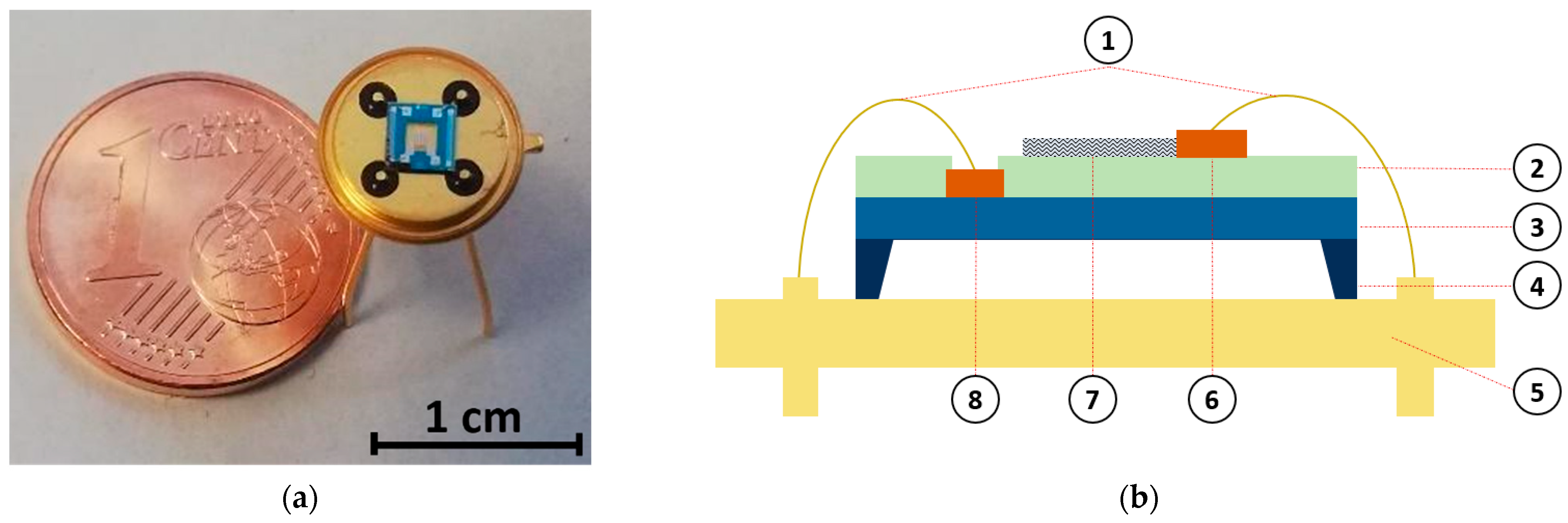
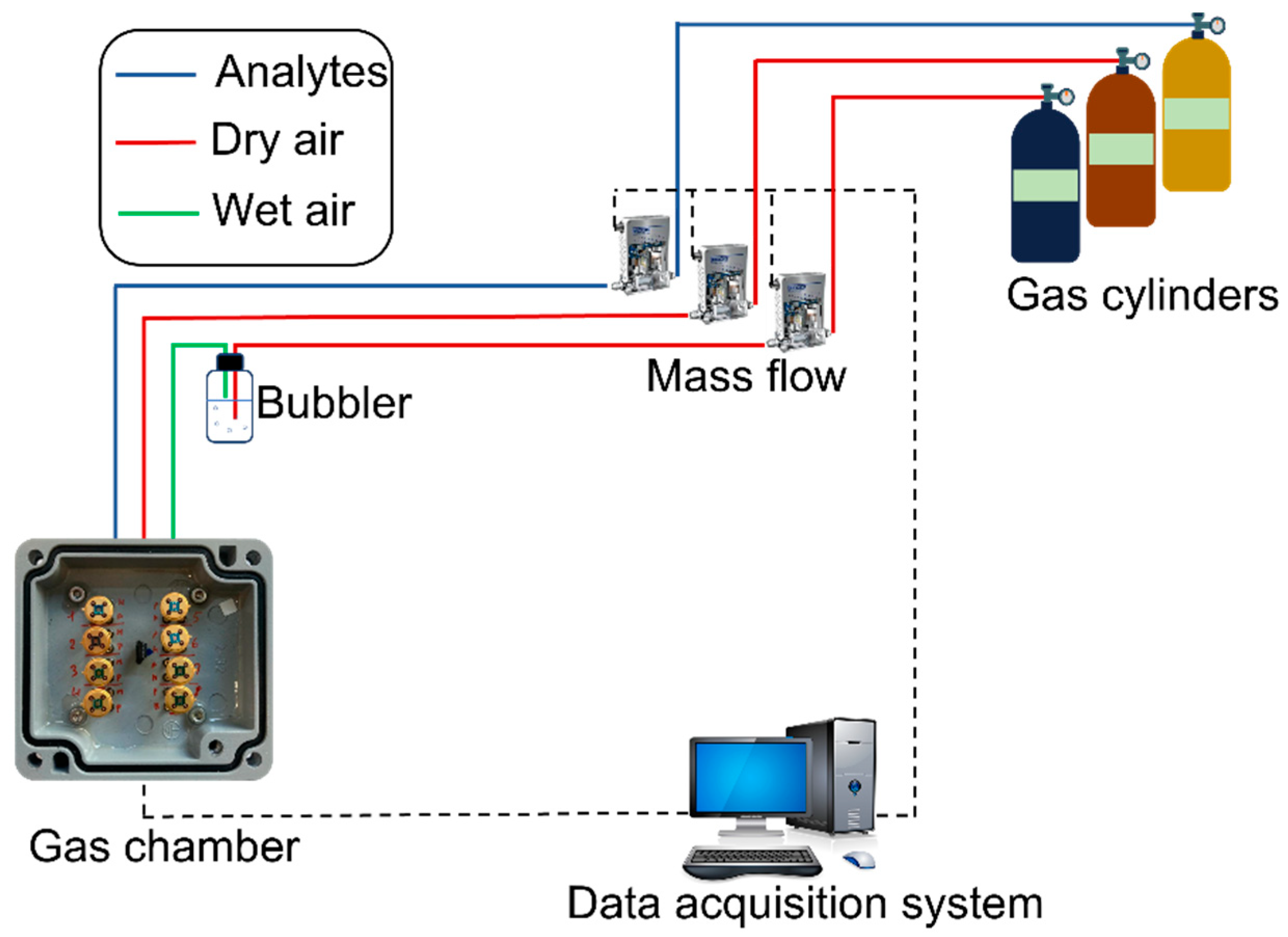
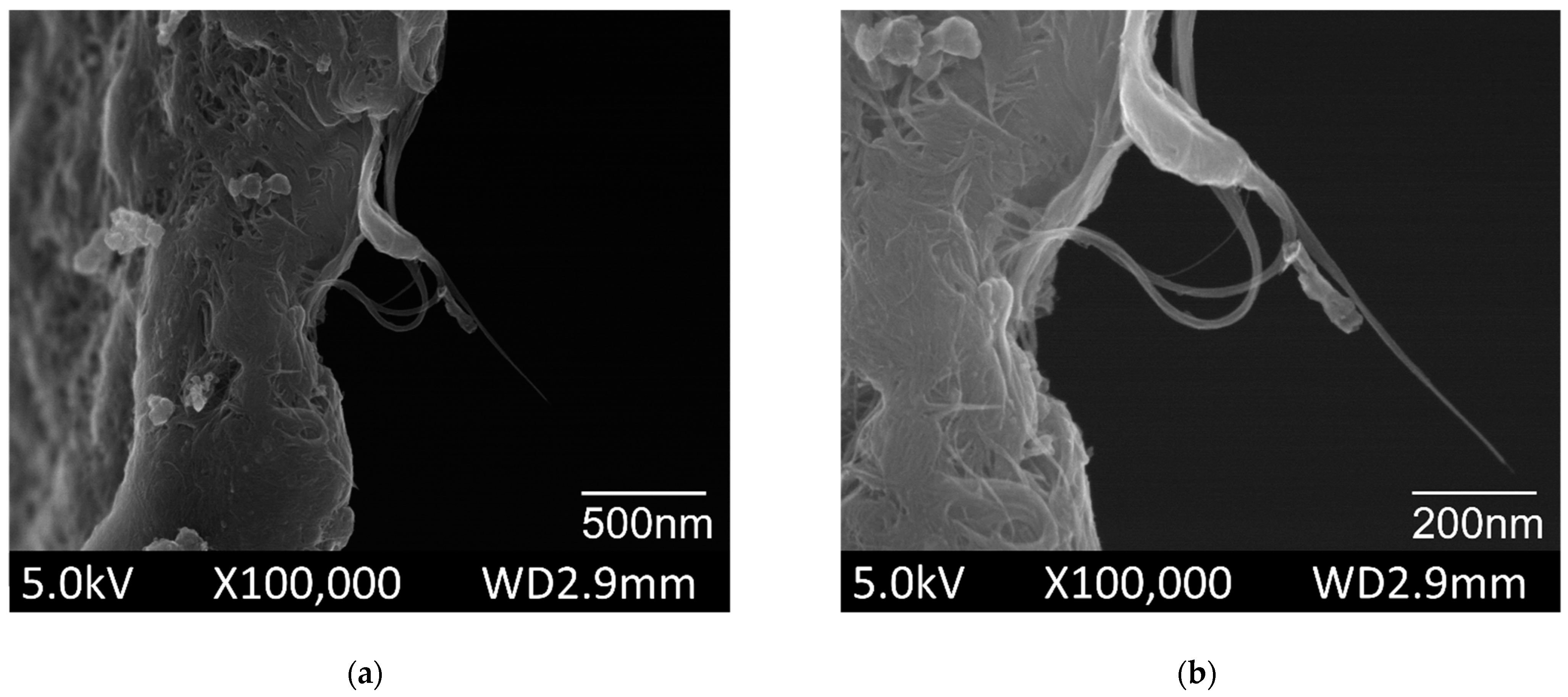
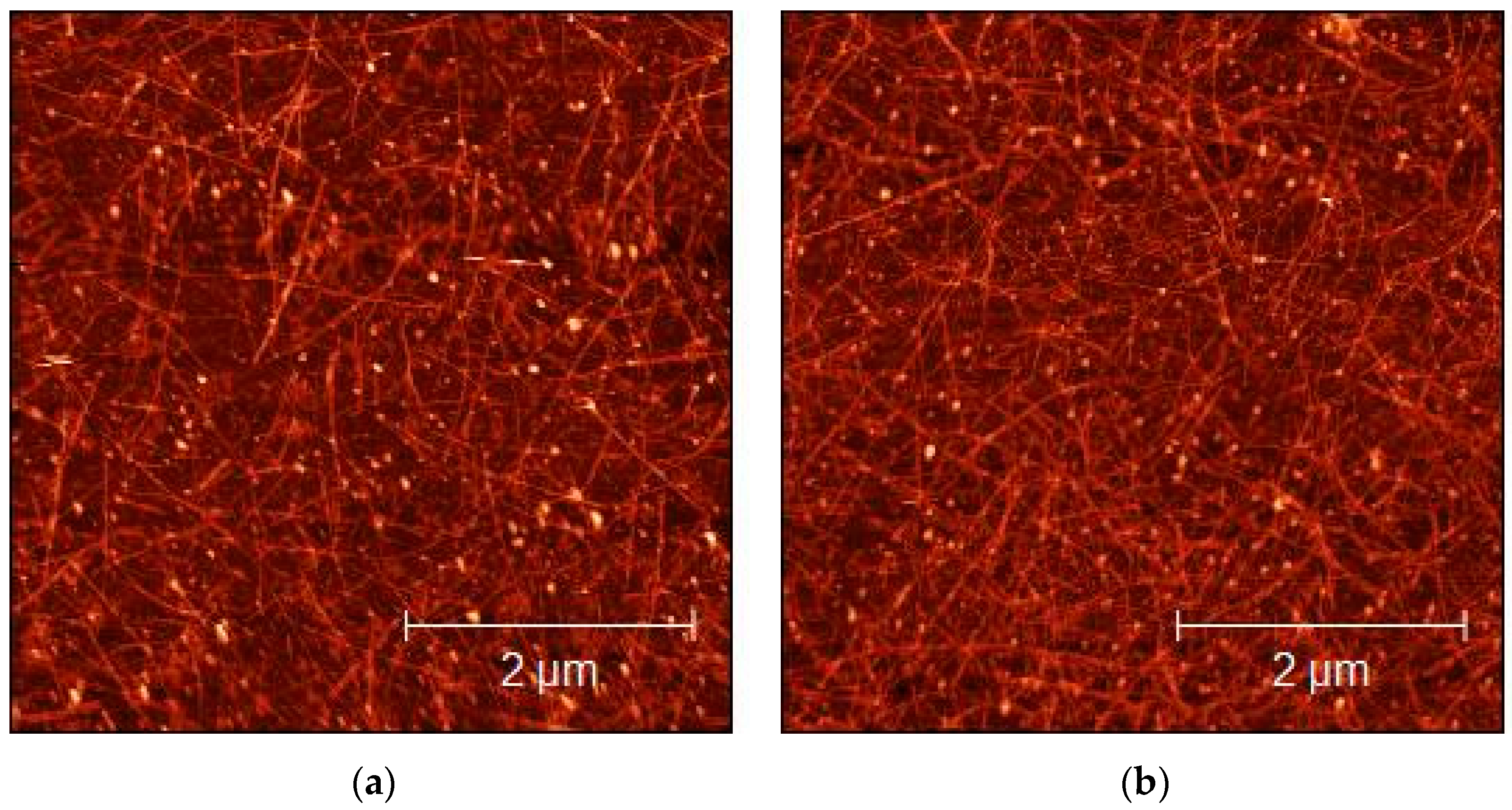
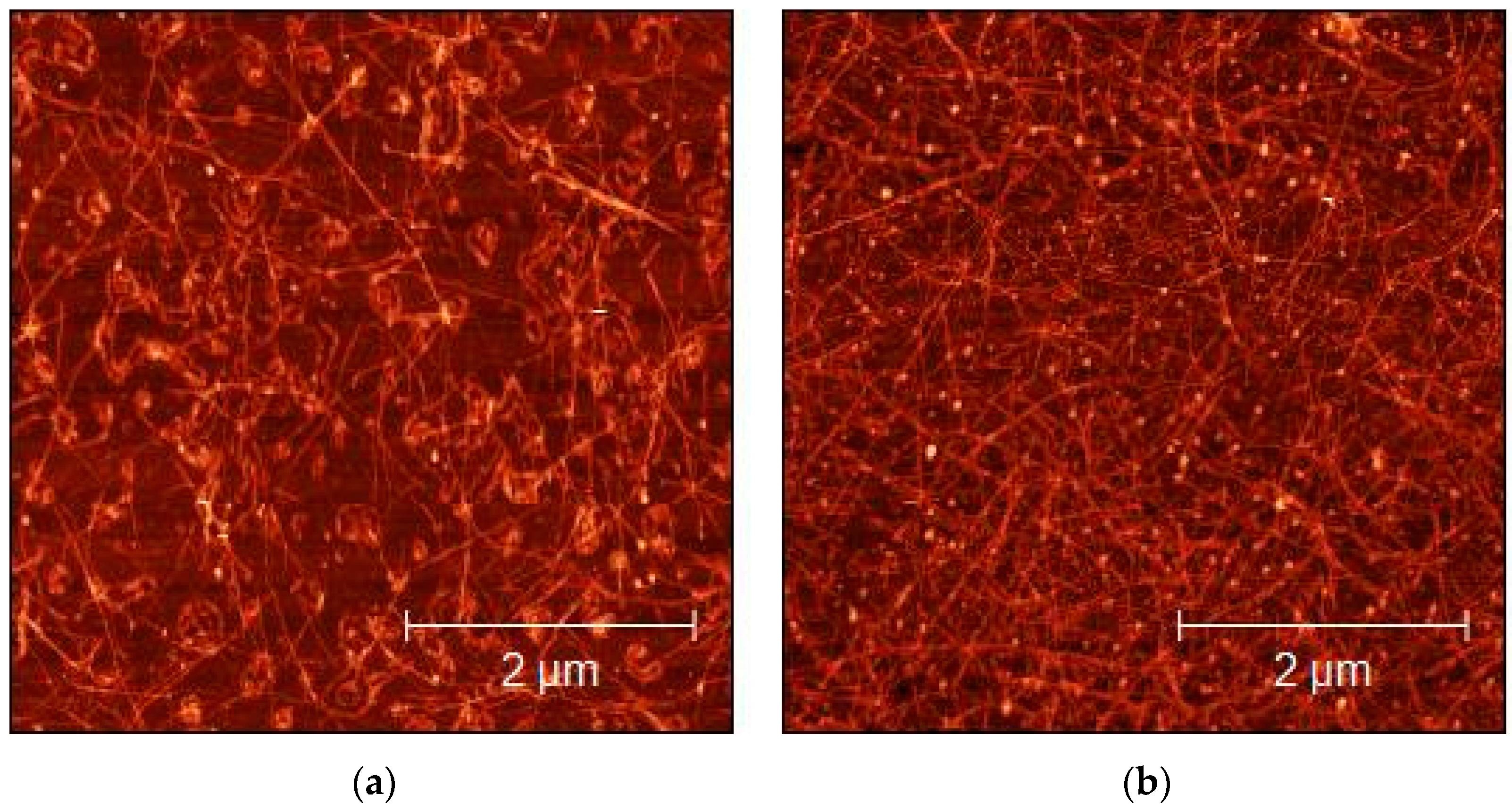
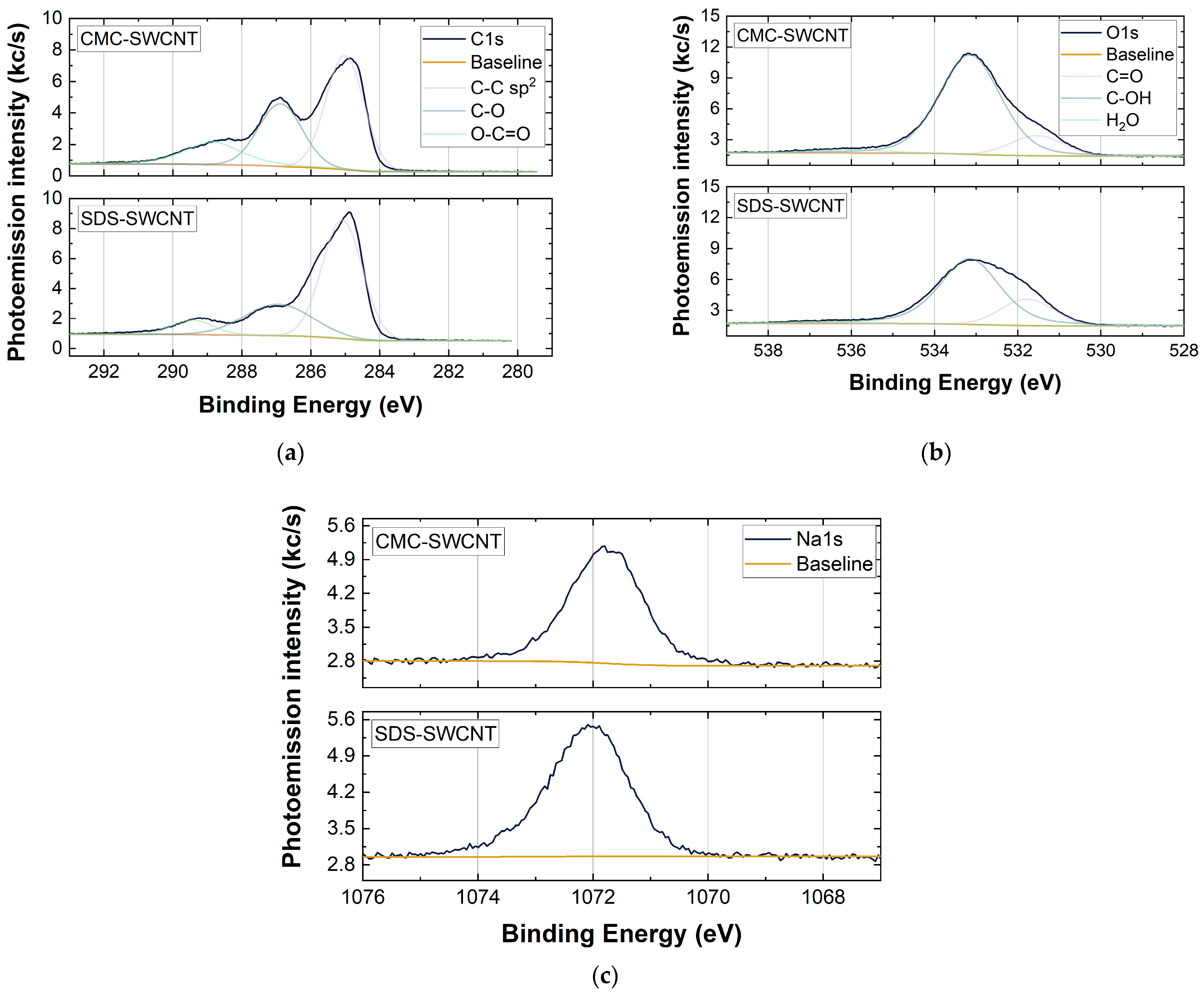
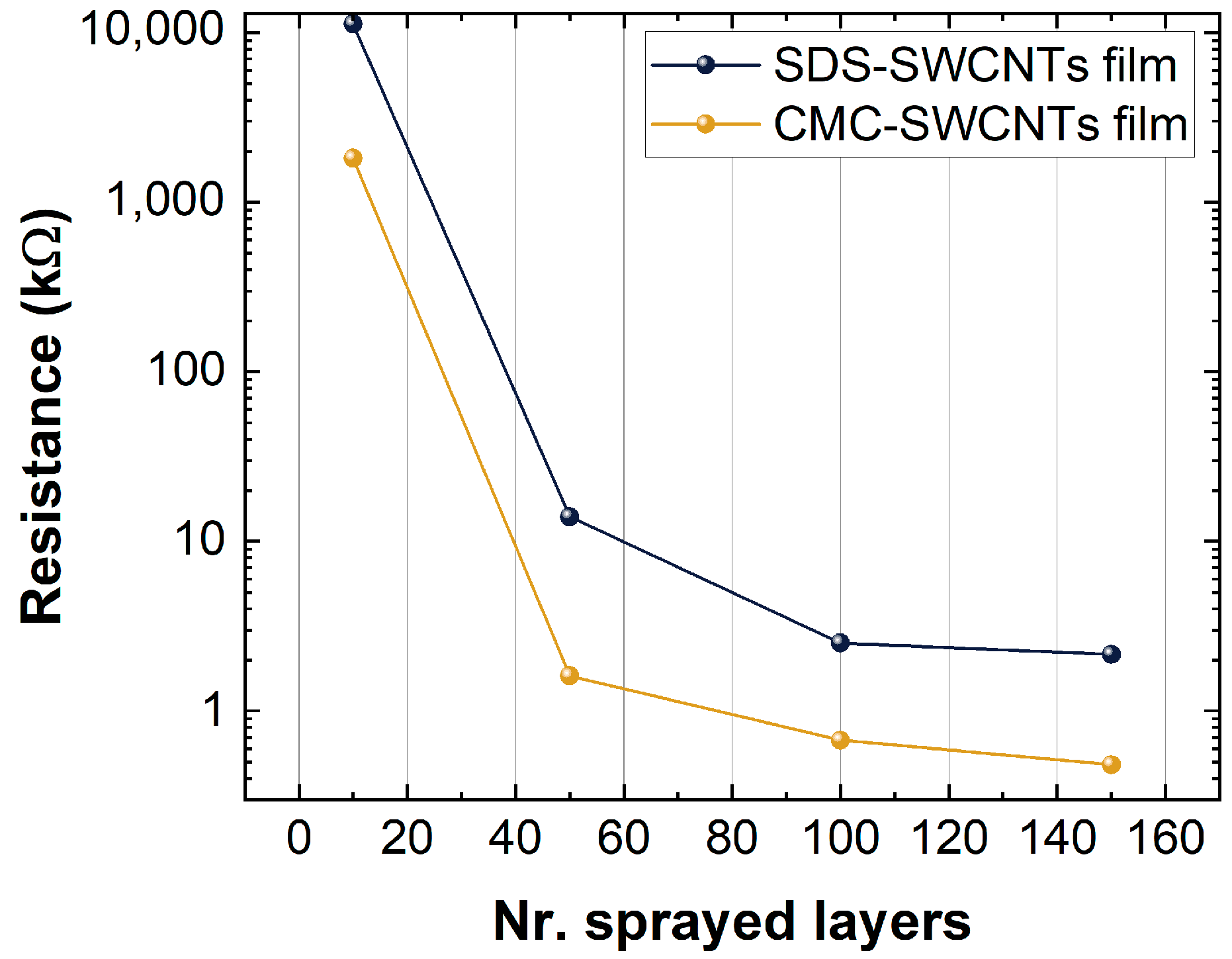
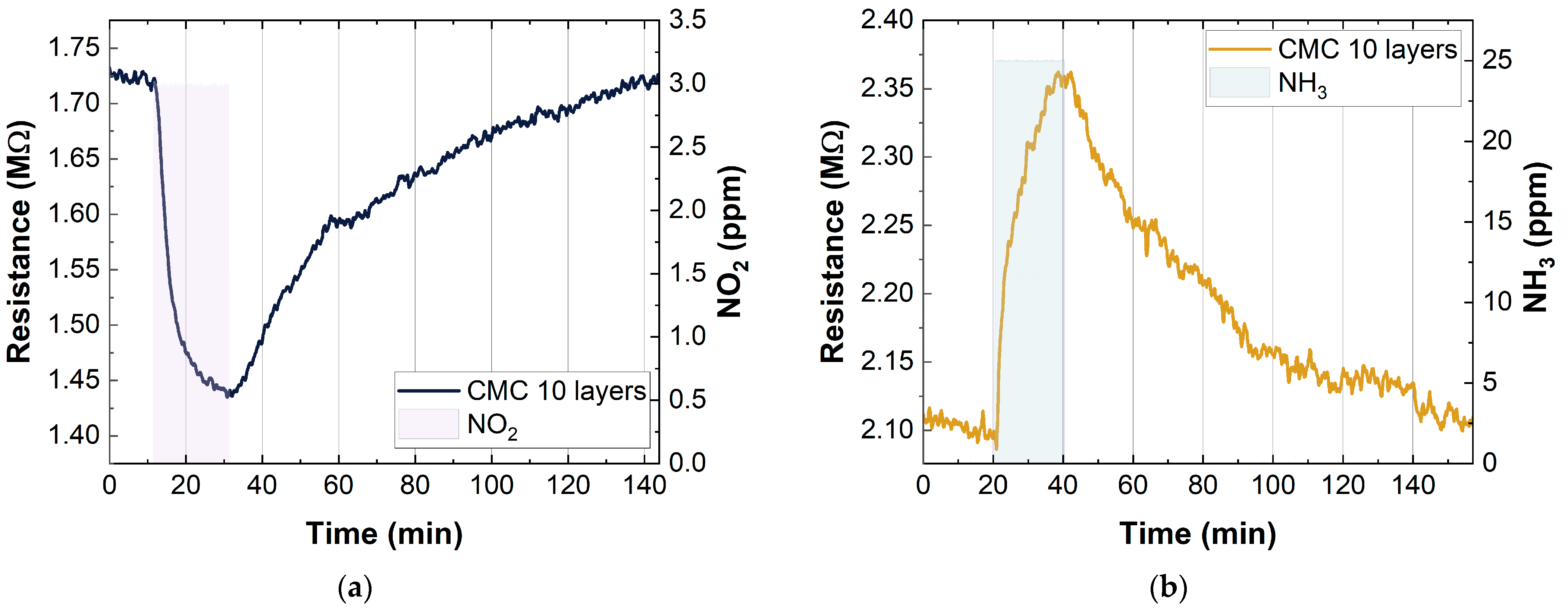
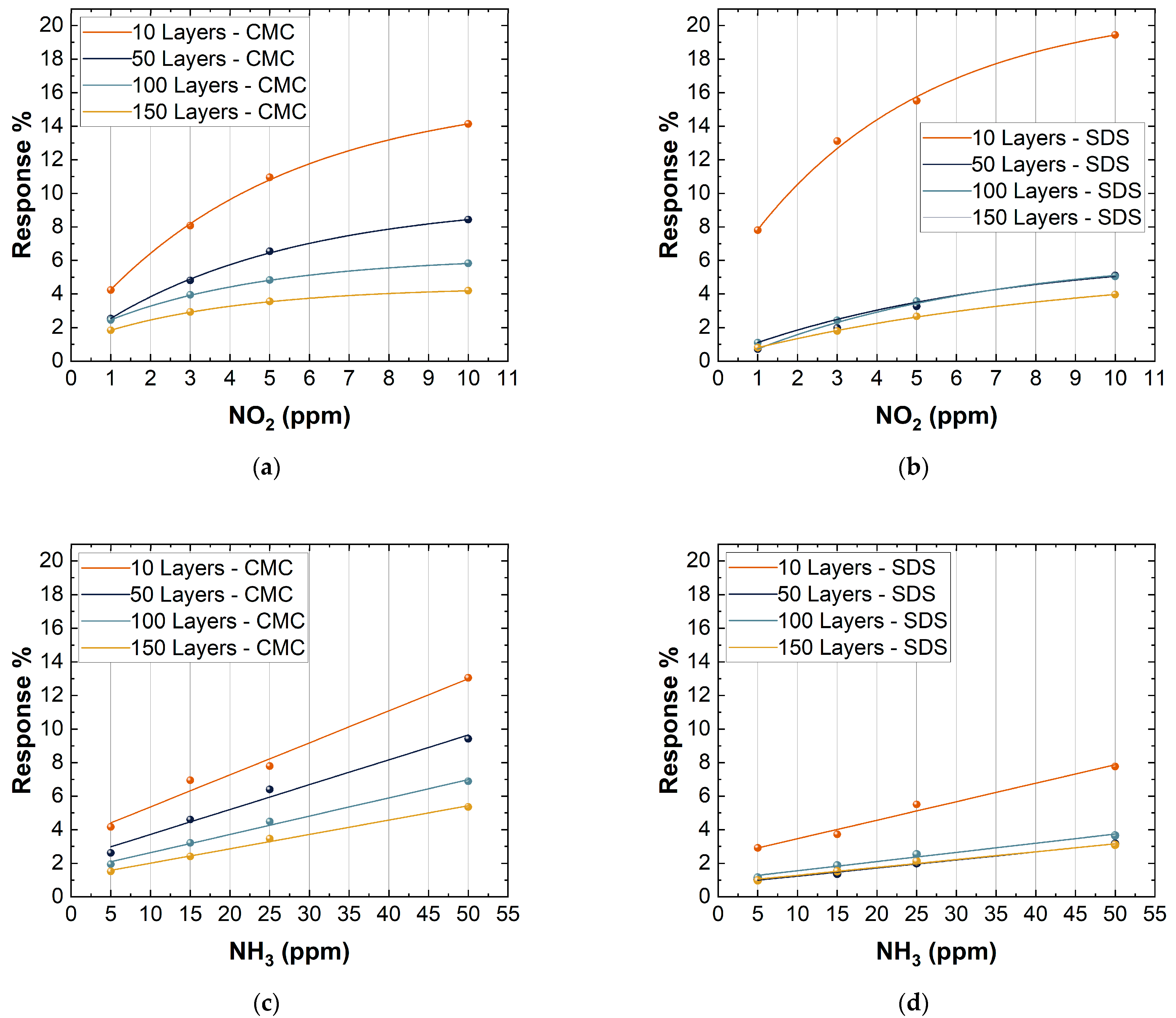

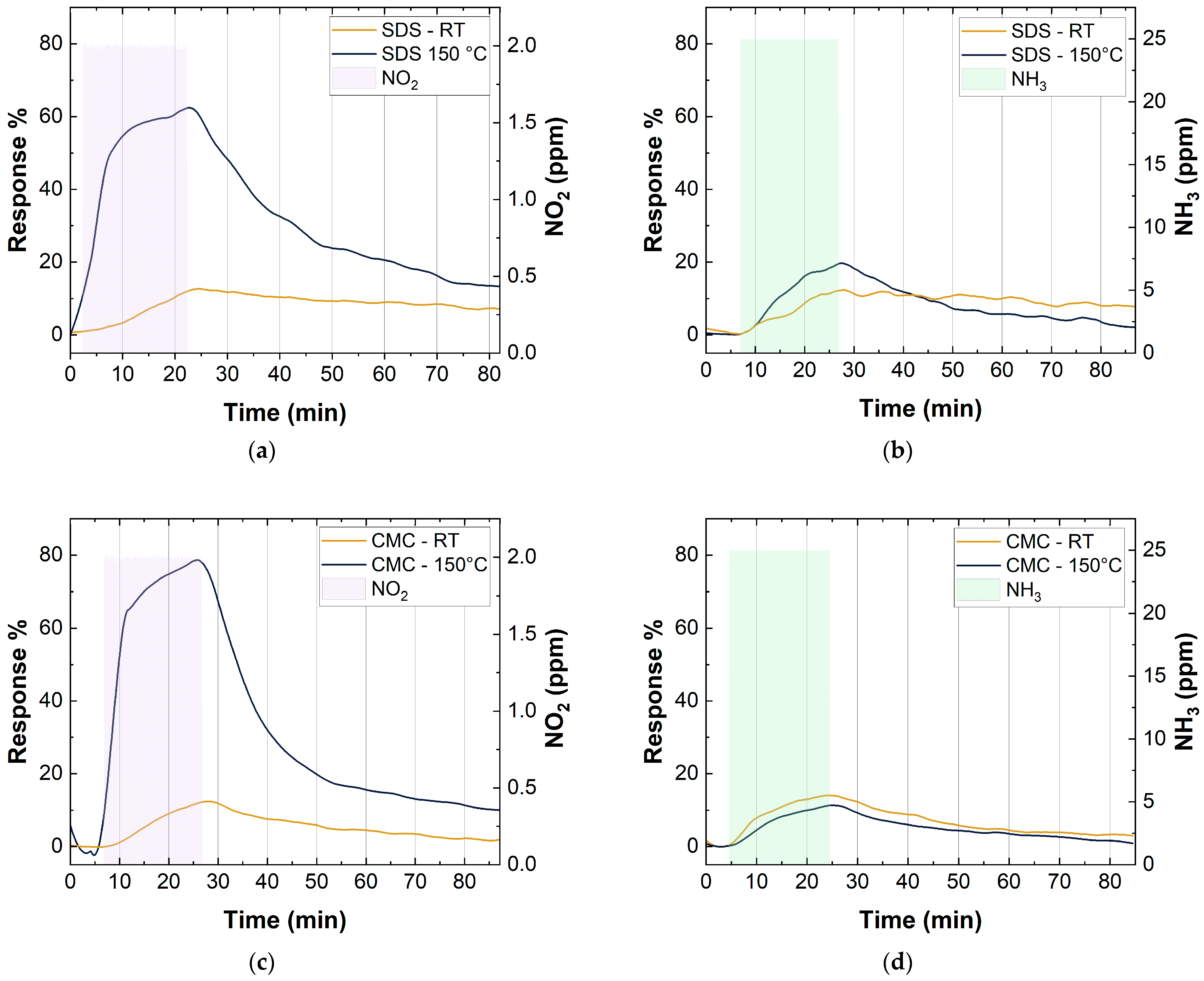
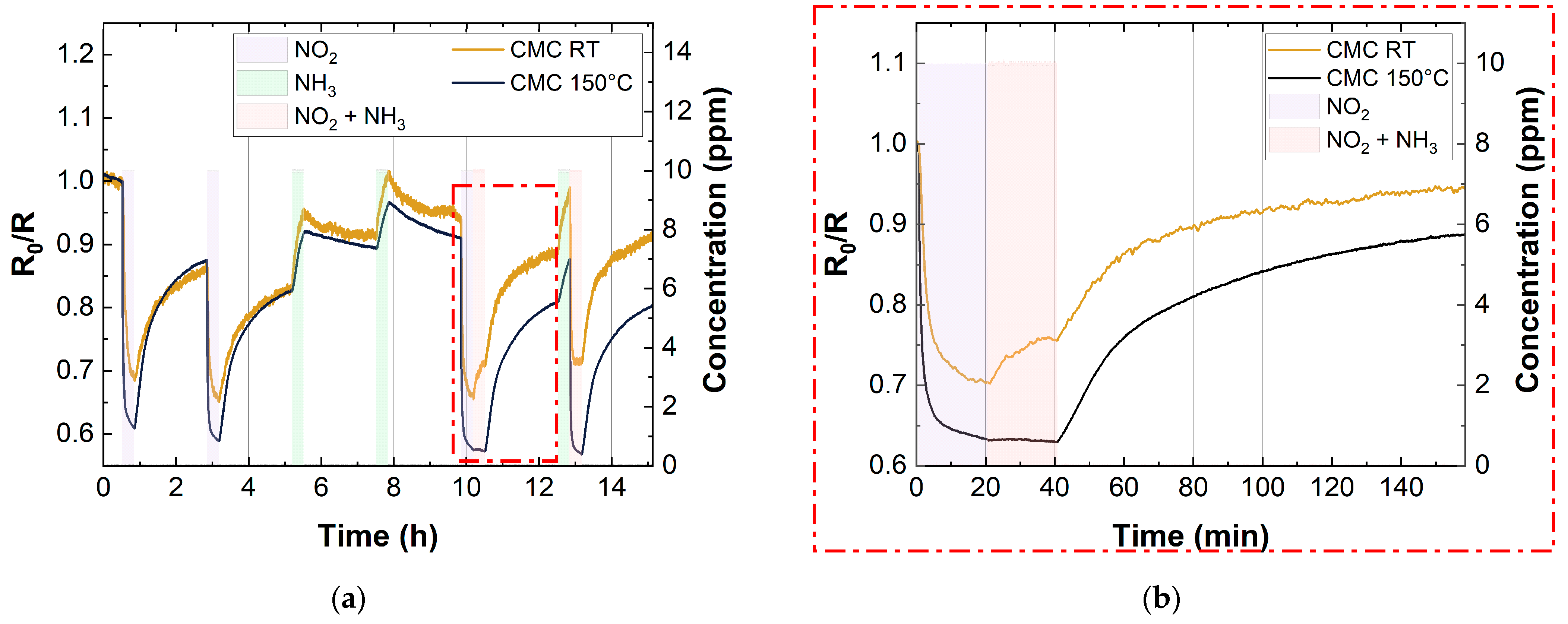
| Sample | Na (at%) | C (at%) | O (at%) |
|---|---|---|---|
| CMC-SWCNT (150 layers) | 2.3 | 69.4 | 28.3 |
| SDS-SWCNT (150 layers) | 3.0 | 72.2 | 24.9 |
| Sample | Layer Numbers | Deposition Thickness (nm) |
|---|---|---|
| CMC-SWCNT | 10 | 1.91 |
| 50 | 5.28 | |
| 100 | 13.68 | |
| 150 | 18.41 | |
| SDS-SWCNT | 10 | 0.51 |
| 50 | 4.65 | |
| 100 | 6.88 | |
| 150 | 9.54 |
| Sensor | Target Gas | Concentration (ppm) | Temperature | Max Response | Recovery Time (Min) |
|---|---|---|---|---|---|
| SDS-SWCNTs | NO2 | 2 | RT | 12.7% | 65.1 |
| 150 °C | 62.5% | 23.1 | |||
| NH3 | 25 | RT | 12.2% | >80 | |
| 150 °C | 19.6% | 22.8 | |||
| CMC-SWCNTs | NO2 | 2 | RT | 12.4 | 25.8 |
| 150 °C | 78.6% | 14.8 | |||
| NH3 | 25 | RT | 14.0% | 28.2 | |
| 150 °C | 11.6% | 23.8 |
| Sensing Material | Target Gas | Deposition System | Concentration | Working Temperature | Response | Ref. |
|---|---|---|---|---|---|---|
| SWCNTs-COOH | NH3 | Drop casting | 50 ppm | RT | 20.2% | [72] |
| SWCNTs | NH3 | Drop casting | 500 ppm | RT | 27.3% | [73] |
| Polyethylenimine (PEI)—SWCNT | NO2 | Chemical vapor deposition (CVD) | 50 ppm | RT | 37% | [74] |
| SWCNTs | NO–NO2 | Chemical vapor deposition (CVD) | 50 ppm | 150 °C | 3.2–5% | [75] |
| Oxydized SWCNTs | NO2 | Spray deposition | 50 ppm | N.A. | 19.3 % | [76] |
| CMC-SWCNTs | NO2 | Spray deposition | 2 ppm | 150 °C | 78.6% | This study |
| SDS-SWCNTs | NH3 | 25 ppm | 19.6% |
Disclaimer/Publisher’s Note: The statements, opinions and data contained in all publications are solely those of the individual author(s) and contributor(s) and not of MDPI and/or the editor(s). MDPI and/or the editor(s) disclaim responsibility for any injury to people or property resulting from any ideas, methods, instructions or products referred to in the content. |
© 2023 by the authors. Licensee MDPI, Basel, Switzerland. This article is an open access article distributed under the terms and conditions of the Creative Commons Attribution (CC BY) license (https://creativecommons.org/licenses/by/4.0/).
Share and Cite
Orlando, A.; Mushtaq, A.; Gaiardo, A.; Valt, M.; Vanzetti, L.; Costa Angeli, M.A.; Avancini, E.; Shkodra, B.; Petrelli, M.; Tosato, P.; et al. The Influence of Surfactants on the Deposition and Performance of Single-Walled Carbon Nanotube-Based Gas Sensors for NO2 and NH3 Detection. Chemosensors 2023, 11, 127. https://doi.org/10.3390/chemosensors11020127
Orlando A, Mushtaq A, Gaiardo A, Valt M, Vanzetti L, Costa Angeli MA, Avancini E, Shkodra B, Petrelli M, Tosato P, et al. The Influence of Surfactants on the Deposition and Performance of Single-Walled Carbon Nanotube-Based Gas Sensors for NO2 and NH3 Detection. Chemosensors. 2023; 11(2):127. https://doi.org/10.3390/chemosensors11020127
Chicago/Turabian StyleOrlando, Antonio, Asma Mushtaq, Andrea Gaiardo, Matteo Valt, Lia Vanzetti, Martina Aurora Costa Angeli, Enrico Avancini, Bajramshahe Shkodra, Mattia Petrelli, Pietro Tosato, and et al. 2023. "The Influence of Surfactants on the Deposition and Performance of Single-Walled Carbon Nanotube-Based Gas Sensors for NO2 and NH3 Detection" Chemosensors 11, no. 2: 127. https://doi.org/10.3390/chemosensors11020127
APA StyleOrlando, A., Mushtaq, A., Gaiardo, A., Valt, M., Vanzetti, L., Costa Angeli, M. A., Avancini, E., Shkodra, B., Petrelli, M., Tosato, P., Krik, S., Novel, D., Lugli, P., & Petti, L. (2023). The Influence of Surfactants on the Deposition and Performance of Single-Walled Carbon Nanotube-Based Gas Sensors for NO2 and NH3 Detection. Chemosensors, 11(2), 127. https://doi.org/10.3390/chemosensors11020127








